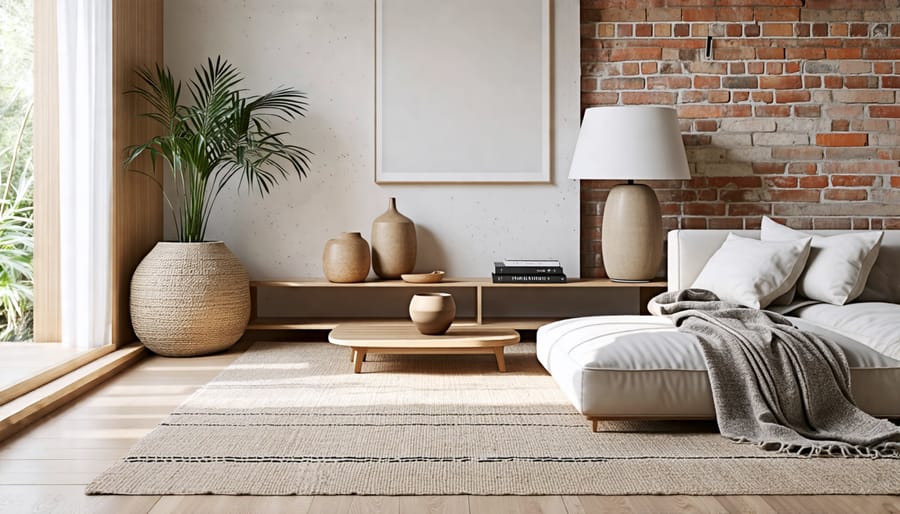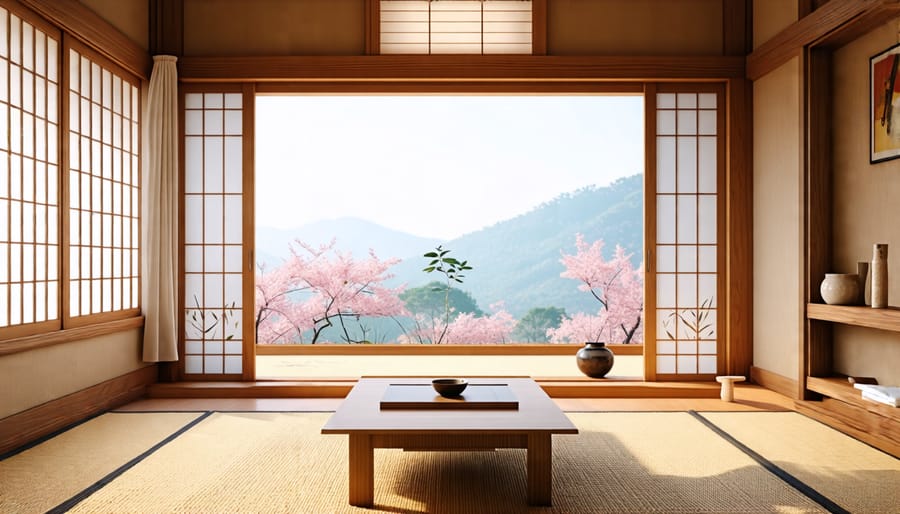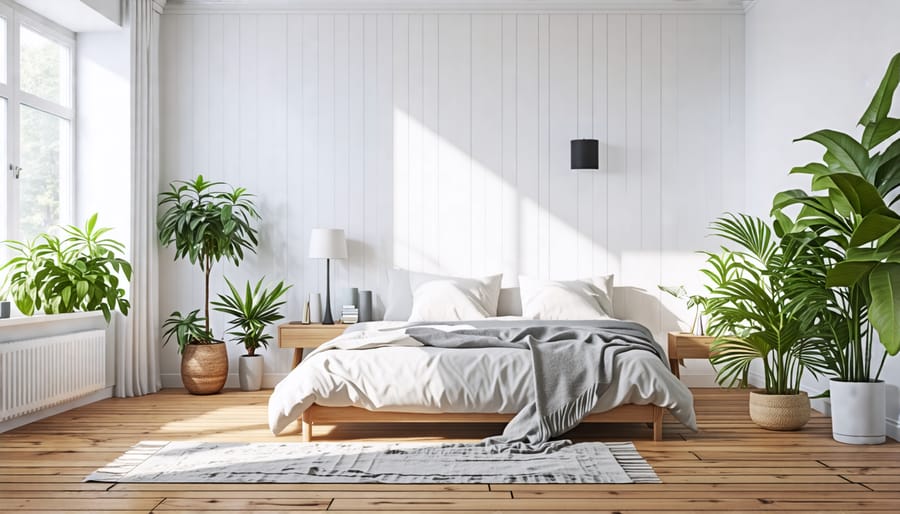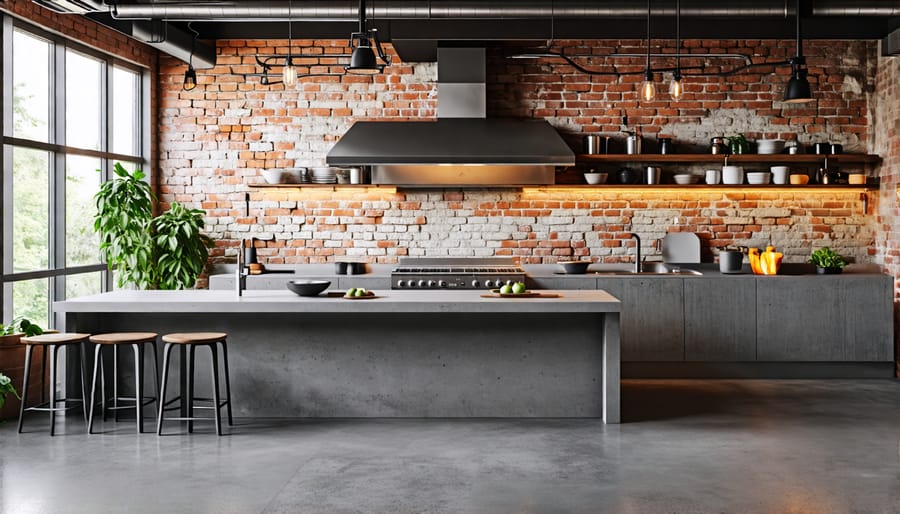
5 Captivating Minimalist Interior Design Styles to Simplify Your Space
Discover the five key types of minimalist interior design: Scandinavian, Japanese, industrial, monochromatic, and mid-century modern. Each style offers a unique approach to simplifying your space while maintaining a chic, inviting atmosphere. Scandinavian minimalism embraces a light, airy palette with natural materials and functional furniture, while Japanese minimalism focuses on clean lines, open spaces, and a connection to nature. Industrial minimalism incorporates raw, unfinished elements like exposed brick and concrete, balanced by sleek, modern fixtures. Monochromatic minimalism creates a striking, sophisticated look by using a single color throughout the space, with varying shades and textures adding depth and interest. Mid-century modern minimalism combines the iconic style’s clean lines and organic shapes with a pared-down, clutter-free aesthetic. To incorporate these styles into your home, start by decluttering and simplifying your space, then select furniture and decor that embody the key characteristics of your chosen minimalist style. Experiment with cozy home decor elements like plush textiles, warm lighting, and natural materials to maintain a welcoming, comfortable vibe while embracing minimalism.
Japanese Minimalism: Zen-Inspired Simplicity
Japanese minimalist design, also known as Zen-inspired simplicity, is a timeless style that embraces a serene, uncluttered aesthetic. This design philosophy emphasizes the use of natural materials, neutral colors, and clean lines to create a tranquil, harmonious living space. By incorporating elements of nature, such as wood, stone, and plants, Japanese minimalism fosters a sense of connection with the environment and promotes relaxation.
To achieve a Japanese minimalist look in your home, start by decluttering and simplifying your space. Keep only essential items that serve a purpose or bring joy, and store the rest out of sight. Opt for a neutral color palette, featuring shades of white, beige, gray, and brown, to create a calming backdrop. Introduce natural textures through wood furniture, bamboo accents, and woven textiles to add warmth and depth to the minimalist design.
Clean lines and simple geometric shapes are hallmarks of Japanese minimalism. Choose furniture with sleek, low profiles and avoid excessive ornamentation. Incorporate sliding doors, shoji screens, and tatami mats to evoke a traditional Japanese aesthetic while maintaining a minimalist approach. Create visual interest by incorporating subtle asymmetry and empty spaces, allowing the eye to rest and appreciate the beauty of simplicity.
Lighting plays a crucial role in Japanese minimalist design. Embrace natural light by keeping windows unobstructed and using sheer or translucent window treatments. Incorporate soft, diffused artificial lighting through paper lanterns, floor lamps, and dimmer switches to create a warm, inviting ambiance. By balancing light and shadow, you can enhance the tranquility of your Zen-inspired space.

Scandinavian Minimalism: Cozy Functionality
Scandinavian minimalist design embraces a “less is more” philosophy, focusing on functionality and simplicity without sacrificing warmth and comfort. This style is characterized by its use of light, neutral colors, such as white, beige, and gray, which create a bright and airy atmosphere. Natural light is a key element, with large windows and sheer curtains allowing sunlight to flood the space.
To achieve a cozy Scandinavian minimalist look, incorporate organic textures and materials like wood, wool, and linen. These elements add depth and warmth to the otherwise clean and simple aesthetic. Opt for furniture with clean lines and minimal ornamentation, such as a sleek sofa or a streamlined coffee table. Incorporate storage solutions that blend seamlessly into the design, such as built-in shelving or hidden cabinets, to maintain a clutter-free space.
Add warmth and personality to your Scandinavian minimalist interior with carefully selected accents. A plush throw blanket draped over a chair, a few potted plants, or a collection of favorite books can make the space feel inviting and lived-in. Experiment with subtle pops of color through artwork, pillows, or rugs to create visual interest without overwhelming the minimalist palette.
Lighting plays a crucial role in creating a cozy atmosphere. In addition to maximizing natural light, incorporate warm, layered lighting through a combination of floor lamps, table lamps, and pendant lights. This will help create a soft, inviting ambiance in the evenings and during darker months.
Remember, the key to Scandinavian minimalism is finding a balance between simplicity and comfort. By embracing functionality, light colors, organic textures, and carefully curated accents, you can create a warm and inviting minimalist space that feels both stylish and livable.

Industrial Minimalism: Raw and Refined
Industrial minimalism combines the raw beauty of utilitarian materials with the sleek sophistication of modern design. This style embraces the unfinished, the exposed, and the functional, creating spaces that are both edgy and refined. Imagine walking into a loft apartment where exposed brick walls, concrete floors, and metal ductwork take center stage. These raw elements provide a canvas for minimalist furnishings and decor, resulting in a space that feels both gritty and glamorous.
To achieve this look, start by celebrating the inherent qualities of industrial materials. Leave brick walls unfinished, showcase the texture of concrete, and let metal finishes develop a natural patina. Balance these rough surfaces with smooth, modern elements like sleek furniture, polished stone countertops, and streamlined lighting fixtures. A monochromatic color palette of blacks, grays, and whites can help unify the space, while pops of color in artwork or accessories add visual interest.
When it comes to furnishings, opt for pieces with clean lines and simple silhouettes. A leather sofa, a metal coffee table, and a few well-chosen industrial antiques can create a sense of history and character. In the kitchen, pair stainless steel appliances with white kitchen ideas for a fresh, modern look. And don’t forget the power of plants – a few strategically placed greenery can soften the hard edges of industrial design and bring a touch of nature indoors.

Monochromatic Minimalism: Elegant Simplicity
Monochromatic minimalism is all about embracing the power of simplicity and elegance through the use of a single color. By limiting your palette to varying shades, tints, and tones of one hue, you can create a serene and sophisticated space that exudes tranquility. The key to mastering this style is to focus on texture, form, and subtle variations in color to add depth and interest to your interior.
To get started, choose a base color that resonates with you and complements your space. Neutral hues like white, gray, and beige are popular choices for their versatility and timeless appeal. However, don’t be afraid to experiment with bolder options like navy blue, forest green, or deep burgundy for a more dramatic effect.
Once you’ve selected your color, incorporate different shades and tints throughout the room. Use lighter tones for walls and ceilings to create a sense of airiness, while reserving darker shades for accents and furniture to ground the space. Play with textures by combining matte and glossy finishes, smooth and rough surfaces, or plush and sleek fabrics to add visual intrigue without overwhelming the eye.
When accessorizing, opt for items that showcase your chosen color in unique ways. A monochromatic color scheme doesn’t have to be boring; consider introducing patterns, prints, or artwork that feature variations of your base hue. Layering these elements will help create a dynamic and inviting atmosphere that feels both cohesive and captivating.
Remember, the beauty of monochromatic minimalism lies in its ability to showcase the essential elements of design – form, texture, and color – in a refined and purposeful manner. By embracing this approach, you can craft a space that radiates elegance and simplicity, offering a peaceful refuge from the chaos of everyday life.
Minimalist Maximalism: A Balanced Approach
Minimalist maximalism strikes a delicate balance between the simplicity of minimalism and the visual interest of carefully chosen statement pieces. This approach allows you to create a space that feels both uncluttered and personalized. Start with a minimalist foundation—a neutral color palette, clean lines, and functional furniture—then thoughtfully layer in eye-catching elements that reflect your unique style.
To achieve this balanced aesthetic, consider incorporating a bold, oversized artwork or a striking sculptural piece that serves as a focal point in the room. An accent wall in a rich, contrasting color or an intricately patterned wallpaper can add depth and dimension without overwhelming the space. When selecting statement pieces, opt for items with interesting textures, such as a plush velvet sofa or a hand-woven tapestry, to add tactile intrigue.
Curate your accessories mindfully, displaying only those that hold personal significance or contribute to the overall design narrative. A collection of vintage vases in varying heights and shapes, or a gallery wall featuring meaningful photographs and prints, can infuse character into the room while maintaining a sense of intentionality.
Remember, the key to minimalist maximalism is restraint. Each element should serve a purpose, whether functional or aesthetic, and contribute to the cohesive vision of the space. By carefully balancing simplicity with strategic embellishments, you can create a home that feels both streamlined and soulful.
Conclusion
In exploring the world of minimalist interior design, we’ve discovered a spectrum of styles that embody the “less is more” philosophy while allowing for personal expression. From the crisp, clean lines of Scandinavian minimalism to the organic warmth of Japanese minimalism, these approaches demonstrate that simplicity need not mean stark or sterile. By focusing on quality over quantity, purposeful placement, and a curated color palette, you can transform your home into a tranquil, uncluttered haven that reflects your unique taste. As you embark on your minimalist design journey, remember that the goal is not perfection but rather creating a space that brings you joy and peace. Experiment with different elements from each style to find the perfect balance for your lifestyle and aesthetic preferences. Embrace the freedom and clarity that comes with living with less, and let your minimalist interior be a beautiful reflection of your authentic self.
